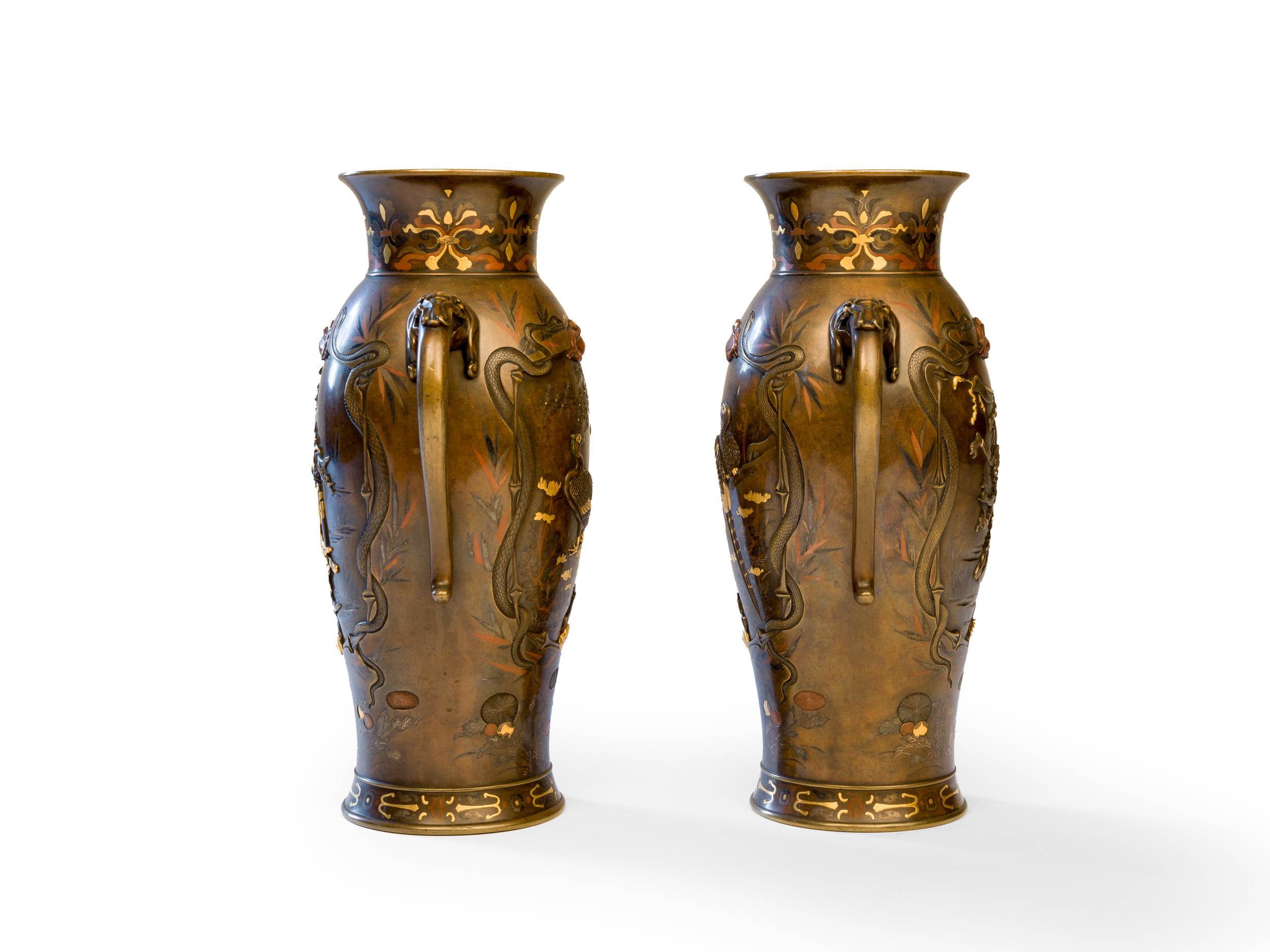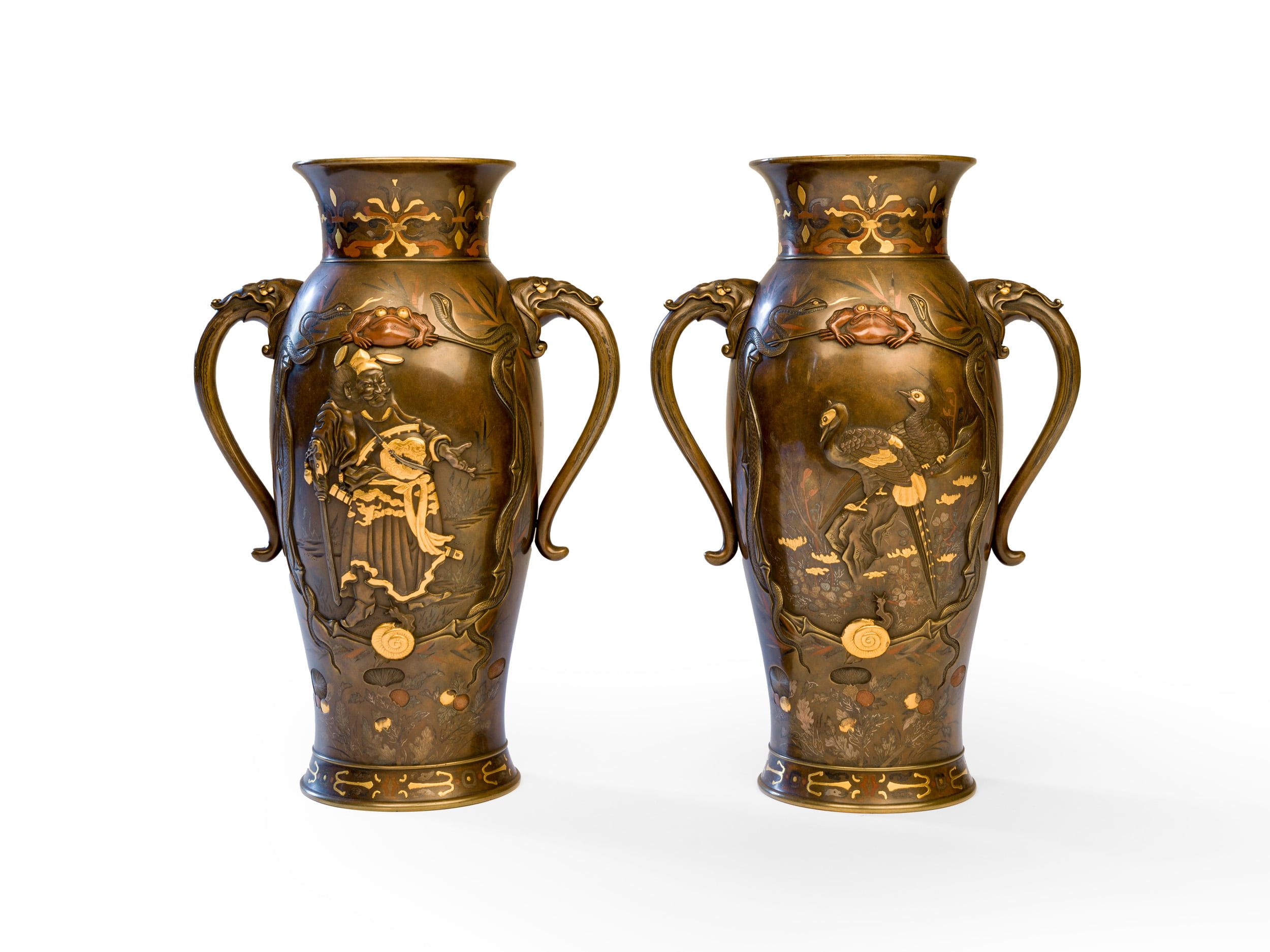Each vase with a baluster body supported on a spreading foot and rising to a gently waisted neck with flat everted rim, the shoulder with two long handles issued from baku heads, the exterior carved in high and sunken (shishiaibori) relief, inlaid in iro-e takazogan and hirazogan, and engraved in katakiri and kebori, with bamboo-framed panels surrounded by two snakes flanking a toad above and a snail below – an impressive example of the sansukumi motif. Each panel shows a different but complementary design, on one vase depicting a proudly standing Shoki holding his sword in one hand and extending the other, with a long-tailed pheasant amid chrysanthemums under a gnarled pine tree to the back; and on the other three oni depicted in different attitudes, one of them fighting back against the demon queller, the back with two long-tailed pheasants perched on a craggy rock. The body is further decorated with bamboo leaves, mushrooms, and leaves, the neck and foot with formalized bands.
HEIGHT each 30.5 cm
WEIGHT each 4.7 kg
The present pair of vases, impressively cast, finely carved in high and sunken relief, and masterfully inlaid in both hirazogan and takazogan, was clearly made by an extremely talented metalworker. The inspired use of inlays makes an attribution to the workshop of Miyao Eisuke reasonable. Although most often associated with large-scale bronze figures of samurai, the Miyao Company also manufactured or dealt in a wide range of craft goods including Shibayama-work panels and ivory figures. Apparently based first in Yokohama and then, after about 1890, in Nihonbashi-ku, Tokyo, the company is first recorded at the second Naikoku Kangyo Hakurankai (National Industrial Exposition) where Miyao Eisuke collaborated with the bronze caster Momose Sozaemon in the production of a bronze figure of seven drunken shojo.
The combination of snake, frog, and snail (or slug) constitutes the sansukumi motif. Sansukumi translates to ‘the three who are afraid of one another’. The three animals are in a state of mutually assured destruction: the snake will consume the frog, however the frog has already eaten a poisonous snail, so the snake must perish as well. This motif is connected to sansukumi-ken, a category of Japanese hand games played by using three hand gestures. The oldest sansukumi-ken game is mushi-ken, a game originally from China. In mushi-ken, the ‘frog’ represented by the thumb wins against the ‘slug’ represented by the pinkie finger, which, in turn defeats the ‘snake’ represented by the index finger, which wins against the ‘frog’. Although this game was imported from China, the Japanese version differs in the animals represented. In adopting the game, the original Chinese characters for centipede or millipede were apparently confused with the characters for the ‘slug’. The centipede was chosen because of the Chinese belief that the centipede was capable of killing a snake by climbing and entering its head. One of the few surviving sansukumi-ken games is jan-ken, which was brought to the West in the 20th century as rock paper scissors.
Provenance:
Private collection, Japan
Private collection, Zürich


Kunstberatung Zürich AG
Börsenstrasse 27 8001 Zürich Switzerland
VAT Number: CHE-113.608.140
+41 44 381 50 40
contact@kunstberatung-zurich.com
©2025 Kunstberatung Zürich AG No part of this website may be reproduced, distributed, stored in a retrieval system or transmitted in any form or by any means, electronic, mechanical, or otherwise, without the prior permission of Kunstberatung Zürich AG.